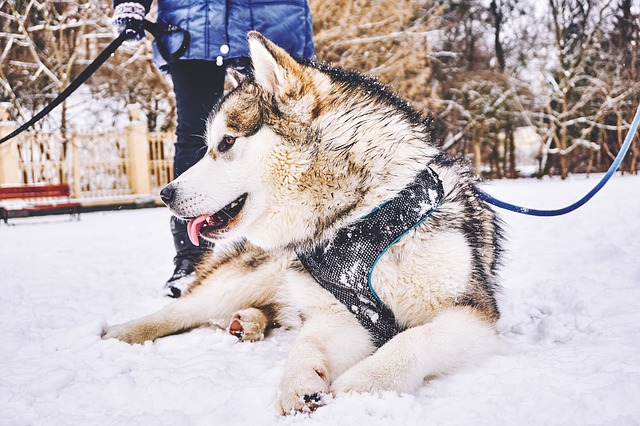Believe it or not, February 22 is National Walk Your Dog Day! While we shiver at the thought of a leisurely stroll in this weather, most dogs love to be outside in the winter. The following are a few frequently asked questions about keeping your furry friend safe during these cold winter months:
Is my dog warm enough?
Keep in mind your dog’s breed when deciding how long they can stay outside and what they need to be comfortable. If your dog’s ancestors came from a northern climate (Huskies, Labradors, Akitas, Bernese Mountain Dogs, German Shepherds, Golden Retrievers, and even Standard Poodles and Tibetan Terriers), they can be happy for hours in the snow with little protection as long as they keep moving. If your dog’s ancestors came from warm climates (Chihuahuas, Greyhounds, Whippets, Papillons, and most terriers), they will be more comfortable outside with a light coat or blanket when the temperatures drop below freezing. Always keep in mind that no matter their breed, no dog should be left tied or kenneled outside in freezing winter weather - they must be able to move to keep warm.
Why do my dog’s paws look so red or dry in the winter? Is this dangerous?
Dogs hate getting snow and ice stuck between their toes! These ice balls can lead to irritation and even frostbite. If your dog starts limping as a result ice balls that are stuck to their paws, do not pull at the ice as this can be very painful on raw skin. Instead, gently warm their feet until the ice begins to melt and fall away. If frosty paws are a problem for your pet, try a wax or petroleum based paw protectant like Musher’s Secret to keep snow from accumulating on your dog’s paws when he goes outside. These paw protectants are also helpful in limiting the amount of road salt that makes contact with your pet’s skin, which can dry out paws, even if is technically “pet safe.” If your dog’s paws are getting dry and cracked despite a paw wax, you can apply a light layer of Vaseline or Vitamin E to your dog’s pads. Just remember that their feet will be slippery for a few hours after application!
Another option for protecting your dog’s paws during snowy winter walks is to buy a set of booties for your adventures. Unfortunately, while we think booties are a great idea for dogs, most dogs don’t agree! If you choose to put booties on your pup, make sure to watch them carefully to ensure they don’t chew up and swallow their unwanted footwear!
Is it ok for my dog to drink puddles with road salt or ice melt?
Road salt can be hazardous to your dog in many ways! Products labeled as “Pet Safe” cannot contain ethylene glycol (anti-freeze), which is deadly if ingested by your pet. However, even “Pet Safe” products can cause problems. Most of these products contain calcium or magnesium chloride salts. If ingested in large enough quantities, usually by drinking a melted snow puddle contaminated with road salt, they can lead to electrolyte imbalances. Worried that your dog may have taken too many tastes out of the puddles you passed by while on a winter walk? Watch for early signs that your pet is suffering from road salt toxicity, which include excessive thirst and urination, drooling, vomiting and, rarely, tremors or seizures. If you have a dog who won’t stay away from munching road salt, consider using sand or kitty litter instead of an ice melting product on your property.
Does my puppy or senior dog need any special treatment this winter?
Puppies have less ability to regulate body temperature, so even northern breeds should wear a jacket and spend shorter periods of time outside. Puppy paws are also much more sensitive to cold and the drying effects of ice melt, so paw protection is important. On the other side of the age spectrum, you may notice that your senior pets seem more stiff and arthritic in the winter. This is not because arthritis worsens in cold weather, but because the small corrections caused by slipping on snow and ice make them sore. Walking your senior pet in areas with good traction can help, but if your pet seems consistently uncomfortable during the winter months, it’s worthwhile to consult your veterinarian about medical and alternative modes of pain control.
We hope you and your furry friends have a safe and cozy end to winter!
The CVH Team

